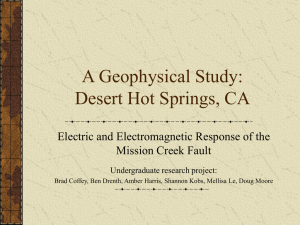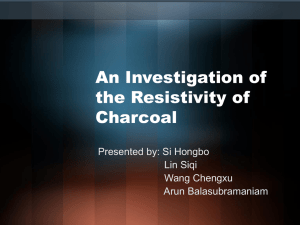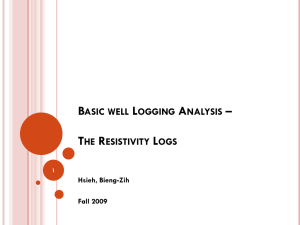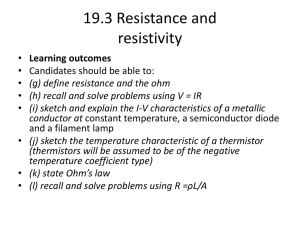Rosalind Hen-Jones - British Geological Survey
advertisement
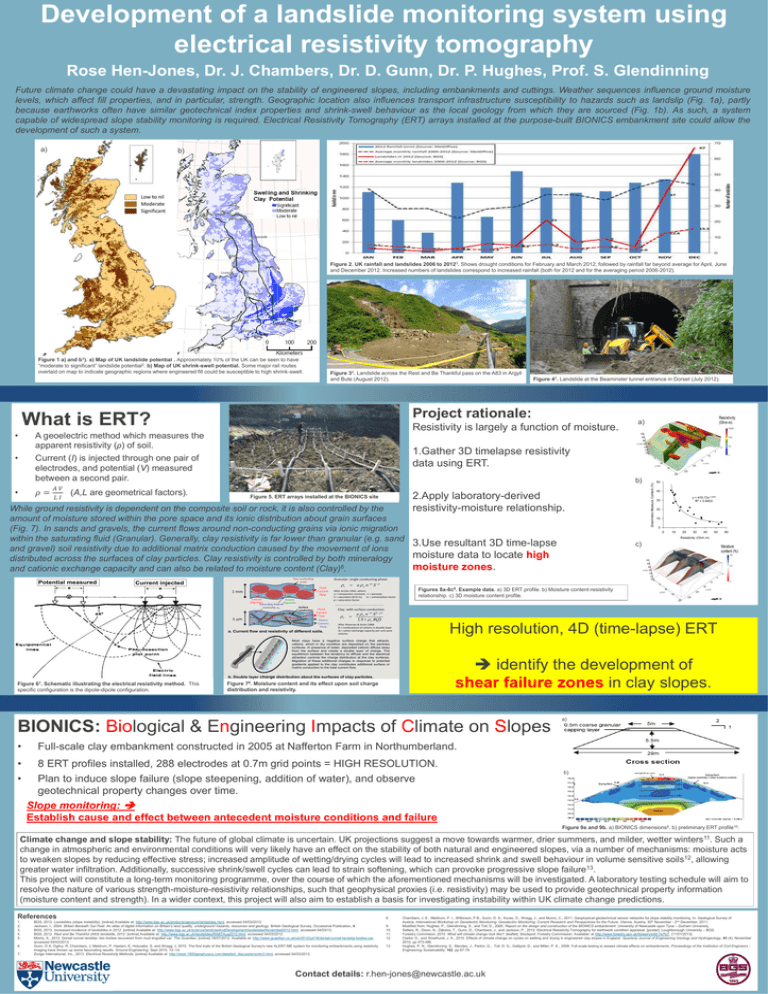
Development of a landslide monitoring system using electrical resistivity tomography Rose Hen-Jones, Dr. J. Chambers, Dr. D. Gunn, Dr. P. Hughes, Prof. S. Glendinning Future climate change could have a devastating impact on the stability of engineered slopes, including embankments and cuttings. Weather sequences influence ground moisture levels, which affect fill properties, and in particular, strength. Geographic location also influences transport infrastructure susceptibility to hazards such as landslip (Fig. 1a), partly because earthworks often have similar geotechnical index properties and shrink-swell behaviour as the local geology from which they are sourced (Fig. 1b). As such, a system capable of widespread slope stability monitoring is required. Electrical Resistivity Tomography (ERT) arrays installed at the purpose-built BIONICS embankment site could allow the development of such a system. a) b) Figure 2. UK rainfall and landslides 2006 to 20123. Shows drought conditions for February and March 2012, followed by rainfall far beyond average for April, June and December 2012. Increased numbers of landslides correspond to increased rainfall (both for 2012 and for the averaging period 2006-2012). Figure 1 a) and b1). a) Map of UK landslide potential . Approximately 10% of the UK can be seen to have “moderate to significant” landslide potential2. b) Map of UK shrink-swell potential. Some major rail routes overlaid on map to indicate geographic regions where engineered fill could be susceptible to high shrink-swell. Figure 34. Landslide across the Rest and Be Thankful pass on the A83 in Argyll and Bute (August 2012). Project rationale: What is ERT? • Resistivity is largely a function of moisture. A geoelectric method which measures the apparent resistivity (ρ) of soil. • 𝜌= 𝐴𝑉 𝐿𝐼 b) (A,L are geometrical factors). 2.Apply laboratory-derived resistivity-moisture relationship. Figure 5. ERT arrays installed at the BIONICS site While ground resistivity is dependent on the composite soil or rock, it is also controlled by the amount of moisture stored within the pore space and its ionic distribution about grain surfaces (Fig. 7). In sands and gravels, the current flows around non-conducting grains via ionic migration within the saturating fluid (Granular). Generally, clay resistivity is far lower than granular (e.g. sand 3.Use resultant 3D time-lapse and gravel) soil resistivity due to additional matrix conduction caused by the movement of ions moisture data to locate high distributed across the surfaces of clay particles. Clay resistivity is controlled by both mineralogy moisture zones. and cationic exchange capacity and can also be related to moisture content (Clay)6. Potential measured Non-conducting grain Current injected - + 1 mm + + Cationic Anionic Migration Migration Saturating Fluid of resistivity, w + 1 m + + Surface conduction - Fluid Current Flow Fluid Current Flow Matrix Current Flow - - - + + + + - + + - + + - + + - + + - + s a w n m S p After Archie 1942, where: a = compaction constant; n = porosity S = saturation (0<S<1); m = cementation factor p = saturation factor Figures 8a-8c8. Example data. a) 3D ERT profile. b) Moisture content-resistivity relationship. c) 3D moisture content profile. Clay: with surface conduction s a w n m S 1 p S w BQ High resolution, 4D (time-lapse) ERT After Waxman & Smits 1968: B = conductance of cations in double layer Q = cation exchange capacity per unit pore volume Most clays have a negative surface charge that attracts. cations, which in dry condition are deposited on the particles surfaces. In presence of water, deposited cations diffuse away from the surface and create a double layer of charge. The equilibrium between the tendency to diffuse and the electrical attraction controls the charge distribution at the clay surfaces. Migration of these additional charges in response to potential gradients applied to the clay contributes additional surface or matrix conduction to the total current flow. identify the development of shear failure zones in clay slopes. b. Double layer charge distribution about the surfaces of clay particles. Figure 76. Moisture content and its effect upon soil charge distribution and resistivity. BIONICS: Biological & Engineering Impacts of Climate on Slopes • • • c) Granular: single conducting phase a. Current flow and resistivity of different soils. Figure 67. Schematic illustrating the electrical resistivity method. This specific configuration is the dipole-dipole configuration. a) 1.Gather 3D timelapse resistivity data using ERT. Current (I) is injected through one pair of electrodes, and potential (V) measured between a second pair. • Figure 45. Landslide at the Beaminster tunnel entrance in Dorset (July 2012). a) Full-scale clay embankment constructed in 2005 at Nafferton Farm in Northumberland. 8 ERT profiles installed, 288 electrodes at 0.7m grid points = HIGH RESOLUTION. Plan to induce slope failure (slope steepening, addition of water), and observe geotechnical property changes over time. Slope monitoring: Establish cause and effect between antecedent moisture conditions and failure b) Figure 9a and 9b. a) BIONICS dimensions9. b) preliminary ERT profile10. Climate change and slope stability: The future of global climate is uncertain. UK projections suggest a move towards warmer, drier summers, and milder, wetter winters11. Such a change in atmospheric and environmental conditions will very likely have an effect on the stability of both natural and engineered slopes, via a number of mechanisms: moisture acts to weaken slopes by reducing effective stress; increased amplitude of wetting/drying cycles will lead to increased shrink and swell behaviour in volume sensitive soils12, allowing greater water infiltration. Additionally, successive shrink/swell cycles can lead to strain softening, which can provoke progressive slope failure13. This project will constitute a long-term monitoring programme, over the course of which the aforementioned mechanisms will be investigated. A laboratory testing schedule will aim to resolve the nature of various strength-moisture-resistivity relationships, such that geophysical proxies (i.e. resistivity) may be used to provide geotechnical property information (moisture content and strength). In a wider context, this project will also aim to establish a basis for investigating instability within UK climate change predictions. References 8. 1. 2. 3. 4. 5. 9. 10. 11. 12. 6. 7. BGS, 2013. Landslides (slope instability). [online] Available at: http://www.bgs.ac.uk/products/geosure/landslides.html, accessed 04/03/2013. Jackson, I., 2004. Britain Beneath Our Feet. An atlas of digital information on Britain’s land quality, underground hazards, resources and geology. British Geological Survey, Occasional Publication, 4. BGS, 2013. Increased incidence of landslides in 2012. [online] Available at: http://www.bgs.ac.uk/science/landUseAndDevelopment/landslides/November2012.html, accessed 04/03/13. BGS, 2012. Rest and Be Thankful (A83) landslide, 2012. [online] Available at: http://www.bgs.ac.uk/landslides/RABTAug2012.html, accessed 04/03/2012. Morris, S., 2012. Dorset tunnel landslip: two bodies recovered from mud engulfed car. The Guardian, [online] 18/07/2012. Available at: http://www.guardian.co.uk/uk/2012/jul/18/dorset-tunnel-landslip-bodies-car, accessed 04/03/2013. Gunn, D A, Ogilvy, R, Chambers, J, Meldrum, P, Haslam, E, Holyoake, S, and Wragg, J. 2010. The first trials of the British Geological Survey's new ALERT-ME system for monitoring embankments using resistivity imaging have thrown up some fascinating results. Ground Engineering, Sept 2010, 12–14. Zonge International, Inc., 2013. Electrical Resistivity Methods. [online] Available at: http://www.1800geophysics.com/detailed_discussions/dm3.html, accessed 04/03/2013. 13. Chambers, J. E., Meldrum, P. I., Wilkinson, P.B., Gunn, D. A., Kuras, O., Wragg, J., and Munro, C., 2011. Geophysical-geotechnical sensor networks for slope stability monitoring. In: Geological Survey of Austria, International Workshop on Geoelectric Monitoring: Geoelectric Monitoring: Current Research and Perspectives for the Future. Vienna, Austria, 30th November - 2nd December, 2011. Modified from: Hughes, P., Glendinning, S., and Toll, D., 2005. Report on the design and construction of the BIONICS embankment. University of Newcastle upon Tyne – Durham University. Sellers, R., Dixon, N., Dijkstra, T., Gunn, D., Chambers, J., and Jackson, P., 2012. Electrical Resistivity Tomography for earthwork condition appraisal. [poster]. Loughborough University – BGS. Forestry Commision, 2010. What will climate change look like?. [leaflet]. Stockport: Forestry Commission. Available: at http://www.forestry.gov.uk/forestry/infd-7s7fc7. [11/01/2013]. Clarke, D., and Smethurst, J. A., 2010. Effects of climate change on cycles on wetting and drying in engineered clay slopes in England. Quarterly Journal of Engineering Geology and Hydrogeology, 43 (4), November 2010, pp 473-486. Hughes, P. N., Glendinning, S., Mendes, J., Parkin, G., Toll, D. G., Gallipoli, D., and Miller, P. E., 2009. Full-scale testing to assess climate effects on embankments. Proceedings of the Institution of Civil Engineers Engineering Sustainability, 162, pp 67-79. Contact details: r.hen-jones@newcastle.ac.uk


